
Berkeley Lab to Host Gulf Coast Scientists
First Femtosecond X-Ray Spectroscopy at ALS
Berkeley Lab to Host Gulf Coast Scientists
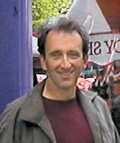
Dennis Lindwall of the Stennis Space Center in Mississippi.
Dennis Lindwall, Ph.D., is a geophysicist and seismologist for the United States Naval Research Laboratory. Today he is also an evacuee both from his hurricane-ravaged hometown of New Orleans and from his research facility. Located 50 miles northeast of the city, the Stennis Space Center was damaged by Katrina and is now closed. But Lindwall will not be kept away from his research for long, thanks to an initiative by Berkeley Lab to host scientists directly impacted by the disaster.
“I appreciate this opportunity to continue with my work at this distinguished laboratory at a time when so many of my colleagues and friends are going through such a great trauma,” he said.
Lindwall’s plight was brought to the attention of Earth Sciences Division Director Bo Bodvarsson, who in turn contacted Director Steve Chu and Deputy Director Graham Fleming, both of whom jumped at the opportunity to help. Beginning later this month, Lindwall will have a place to work in Earth Sciences, in collaboration with the division’s deputy director, Ernie Majer.
“I am very pleased to provide the space and resources for our new colleague,” Bodvarsson said. “Our division will give him a warm welcome, and we look forward to working together to advance our scientific programs.”
Lindwall will not be the only scientist with a home away from home while his facility is being rebuilt. Berkeley Lab has created a website through which scientists from institutions that were either shut down or damaged by Hurricane Katrina can apply for research assistance.
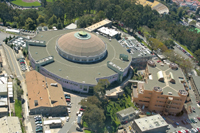 As a national user facility, Berkeley Lab’s Advanced Light Source is in a good position to offer a temporary home to users and other researchers from across the country.
As a national user facility, Berkeley Lab’s Advanced Light Source is in a good position to offer a temporary home to users and other researchers from across the country.
“All of us at Berkeley Lab are greatly saddened by the loss of life and the suffering from Hurricane Katrina,” said Deputy Director Graham Fleming. “Our thoughts go out to those who have been injured and have lost loved ones, homes and community resources.”
As a national user facility, Berkeley Lab’s Advanced Light Source is particularly well positioned to assist scientists nationwide. “We are accustomed to accommodating users — finding them places to stay, offices to work in, headquarters for their experiments,” said Neville Smith, scientific director for the ALS.
One such user is David Ederer, a professor of physics from Tulane University in New Orleans, who just happened to be away on travel when Katrina struck. He arrived at Berkeley Lab just last week. “We’re encouraging him to stay here as long as is needed,” Smith said. “We’ll find him a desk and financial assistance, whatever it takes. We’re here to help.”
Requests to work at Berkeley Lab will be evaluated on a case-by-case basis by each division and with the full support of the Department of Energy’s Office of Science, according to Michael Chartock, the Laboratory’s director for planning and development. He added that he’s been touched by the outpouring of support from Lab employees who offered to help in any way they can — from assisting with inquiries about scientists in the Gulf Coast area to offering housing to stranded researchers.
“Many people at the Laboratory have expressed their willingness to reach out and help people in impacted areas,” Chartock said. “I think it’s wonderful that people here are so interested to lend a hand, and I’m very pleased that Berkeley Lab can offer this kind of assistance to the larger laboratory community. I hope people will avail themselves of this offer.”
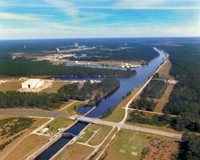
The Stennis Space Center, located 50 miles northeast of New Orleans, was one of the research facilities damaged by Hurricane Katrina. Berkeley Lab will soon host one of its scientists.
The Laboratory may also assist hurricane-impacted areas with educational resources. Some institutions, such as Louisiana State University (LSU), were inundated not by flood waters but by students from higher education institutions directly impacted by the hurricane. LSU is struggling to meet those needs and is seeking help, particularly with physics and astronomy instruction. Anyone interested in teaching classes may contact Dana Browne of LSU’s department of physics and astronomy at (225) 578-6843.
“Where we can help the most is in ensuring the continuity of scientific and educational programs,” said Neville Smith.
The Laboratory’s main offer of assistance includes access to available facilities and office space, shared equipment usage, telecommunications, and computing resources. It does not include travel, housing and living expenses. The Laboratory’s actions are being coordinated with the University of California, the Office of Science, and emergency management organizations, including FEMA and the Red Cross for humanitarian and family support.
How long impacted scientists will stay at Berkeley Lab will depend on the resources available and the nature of each individual partnership, according to Chartock. But returning home will probably be the most ardent wish of even the happiest Berkeley Lab visitors.
“I know that I will learn a great deal from being in the rich scientific culture at this lab and hope to make some contribution of my own,” said Lindwall. “However, my greatest wish is to return to my home city and its jazz, fine food, and steamy weather.”
First Femtosecond X-Ray Spectroscopy at ALS
Scientists working at Berkeley Lab’s Advanced Light Source (ALS) have reported the first femtosecond x-ray spectroscopy experiment. Using a beam of ALS x-rays that were “laser-sliced” into pulse lengths of about 150 femtoseconds, the research team performed time-resolved x-ray absorption spectros-copy measurements on samples of vanadium dioxide. This material has been shown to change from an electrical insulator to a conductor in about 80 femtoseconds.
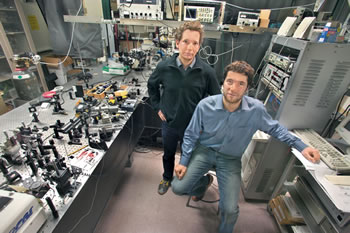
Matteo Rini (left) and Andrea Cavalleri used femtosecond spectroscopy techniques with visible light to measure the speed at which thin films of vanadium dioxide make the phase transition from an electrical insulator to a conductor. Now, scientists are using femtosecond spectroscopy with x-rays to study the material�s electronic structure during this transition.
“We have demonstrated the ability to generate and use sliced x-rays in an energy range that cannot be reached with any other femtosecond x-ray source,” said Andrea Cavalleri, a physicist who was with Berkeley Lab’s Materials Sciences Division (MSD) at the time of the experiments and is now with Ox-ford University. “The laser-slicing technique we used at the ALS is currently the only proven method to generate broadband x-ray pulses of femtosecond duration.”
As a member of the femtosecond spectroscopy group of MSD physicist Robert Schoenlein, Cavalleri had been conducting investigations into the superfast insulator-to-metal transition in thin films of vanadium dioxide. The ability of vanadium dioxide, a non-magnetic semiconductor, to change from a transparent insulator to a reflective conductor was first reported back in 1959, but the speed at which the phase transition takes place was only recently clocked by Cavalleri and Matteo Rini, another member of Schoenlein’s group (see The View, May 13, 2005).
Vanadium dioxide belongs to a class of materials that includes high-temperature superconductors and ferroelectrics, which hold great promise for future high-speed optical switches and other devices. In these materials, there is known to be a strong relationship between structural and electronic effects, but a much better understanding of the physics behind these effects is needed before they can be commercially exploited.
It is a situation that calls out for femtosecond x-rays, which can be used to probe electronic and magnetic effects, as well as the short-range atomic structures of specific elements in a material. However, to date, femtosecond x-ray studies have been limited almost exclusively to time-resolved diffraction ex-periments using hard (high-energy) x-ray pulses.
In addition to being tunable to the chemical property wavelengths of specific elements, ALS x-rays are also bunched in pulses. The pulse lengths of the photon beams directly extracted from the electron beam are in the picosecond (trillionths of a second) time scale. These picosecond pulse lengths, however, can be sliced into femtosecond pulse lengths thanks to a technique originally proposed in 1996 by Alexander Zholents and Max Zolotorev, physicists at Berkeley Lab’s Center for Beam Physics in the Accelerator and Fusion Research Division (AFRD), and further developed under the leadership of Schoenlein.
The technique utilizes femtosecond pulses of light from an optical laser to produce energy modulations in an electron beam. In this case, the laser light pulses are sent through a wiggler magnetic device at the same time as the ALS electron beam. Sending a relativistic beam of electrons through a magnetic wiggler (or undulator) oscillates the motion of the speeding electrons, causing them to lose energy in the form of light emission. The addition of the laser beam modulates the energy loss/ light emission of the oscillating electrons.
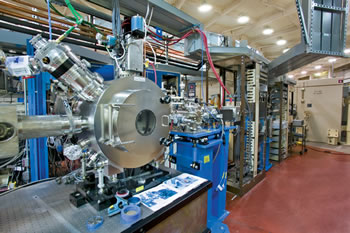 Beamline 6.0.1, dubbed the “Ultrafast X-Ray Facility,” is scheduled to be commissioned this fall. It will be optimized for the generation of pulses of x-ray light on a femtosecond timescale.
Beamline 6.0.1, dubbed the “Ultrafast X-Ray Facility,” is scheduled to be commissioned this fall. It will be optimized for the generation of pulses of x-ray light on a femtosecond timescale.
This energy modulation makes it possible to select and spatially separate or “slice” femtosecond-sized bunches of electrons from the main electron beam. When these displaced electron bunches are then sent through a bend magnet, they generate femtosecond pulses of x-ray light.
“In making use of laser-sliced synchrotron pulses, we combine the broad tunability of bending-magnet radiation with the femtosecond time duration of mode locked lasers,” Cavalleri said. “For the vanadium dioxide experiment we used this technique to follow the way electrons are being shuffled among different orbitals during a photo-induced phase transition. This could not have been done with previous femtosecond techniques and it will be very important in future studies of ultrafast magnetic phenomena and chemical dynamics at surfaces in the gas phase, or in liquids.”
The vanadium dioxide femtosecond spectroscopy experiments were carried out using the wiggler magnet at ALS Beamline 5.0.2, which powers most of the protein crystallography research at the ALS, the bend magnet for Beamline 5.3.1, and a high-power titanium-sapphire laser. A future ALS beamline, 6.0.1, dubbed “The Ultrafast X-Ray Facility,” will be optimized for the generation of femtosecond x-ray pulses through an increase in flux.
Said Schoenlein, “The ultrafast x-ray facility will be based on an in-vacuum undulator (the premier ALS magnetic insertion device) and will have two branch lines, one for hard x-rays and the other for soft x-rays. The soft x-ray branch line will be completed in the next few weeks, and we expect to start commissioning before the end of September. The hard x-ray branch line will be completed next spring.”
Science the Star During Governor Schwarzenegger�s Visit
The Advanced Light Source had seen nothing quite like it since Hollywood Director Ang Lee and his production team spent a long weekend filming scenes for The Incredible Hulk in 2002.
Lights! Camera! Action!
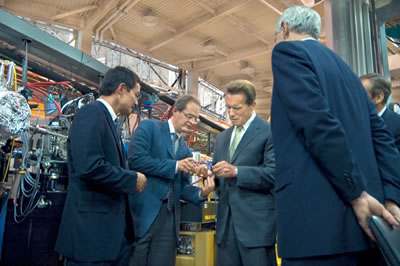
Paul Alivisatos demonstrates ALS technology to California Governor Arnold Schwarzenegger during a tour of the facility on August 19, as Calvin Chou of UC Berkeley and Chancellor Robert Birgeneau look on. photo by Steve McConnell / UC Berkeley NewsCenter
This time, the very brief scene that unfolded at the ALS featured international superstar Arnold Schwarzenegger, in his current role as governor of the State of California, and was directed by Berkeley Lab’s Steve Chu. On this day, August 19, for about an hour, the actor-turned-political leader saw first-hand the dazzle and promise of big-time science.
Reviews were extremely positive. With a half-dozen TV cameras rolling, the Governor talked about the “absolutely incredible” things that he saw and heard on his tour. University of California President Robert Dynes called him an “incredible partner” in support for higher education, and Chu acknowledged the Governor’s backing for research in the state.
There’s no telling what the next act will be with this cast, but if it’s anything like the first one, Berkeley Lab and the state can expect boffo results.
Lab Booth a Big Draw at Solano Stroll

Above: Among those staffing the Berkeley Lab booth at last Sunday’s Solano Stroll were Alex Kouprine (left), Julie Hart and Don Medley.
People love the Solano Stroll, as evidenced by the thousands who throng there every year in early September. Last Sunday was no different, as sunny skies and a festive atmosphere greeted those who converged on this popular street in North Berkeley and Alameda to take in crafts, entertainment and delicious food.
Among the many booths there was Berkeley Lab’s, staffed by 16 tireless volunteers who spent the day sharing the Lab’s story with passers-by. Approximately 1,500 people stopped by, according to Terry Powell of the Lab’s Community Relations Office, which organizes the booth.
“The most frequent question was when the next Open House is taking place,” she said. “After that, it was science teachers looking for instruction materials, training tools, and information on tours.”
 Berkeley Lab’s Al Smith (center) and Darcy Peterka discuss Lab programs with passers-by.
Berkeley Lab’s Al Smith (center) and Darcy Peterka discuss Lab programs with passers-by.
Spending time at the booth during the day were Michael Beaudrow, Rene C. Bilodeau, Allan Chen, Ana Galvan, Julie Hart, Beverly Harris, Alex Kouprine, Dinah Levy, Don Medley, Sally Nasman, Darcy Peterka, Powell, Gallia Singer, Al Smith, Jane Tanamachi, and Wanli Yang.
While booth volunteers were sharing science information, two Lab employees were providing another kind of valuable service to Solano Stroll visitors. Sherri Cheeseboro played drums with Apocalypso Now, and Martin Jara strummed along with the Cajun All-Stars.
Which just goes to show what a multitalented and generous bunch Lab employees are.
-- Lyn Hunter
A Talk with Evan Mills
Insurance Risk and Climate Change
Hurricane Katrina is expected to cause $35 billion in insurance claims, a sum the insurance industry will be able to shoulder. But what if the number of weather-related catastrophes is on the rise? Evan Mills, a scientist in Berkeley Lab’s Environmental Energy Technologies Division, has spent more than a decade tracking evidence that the global insurance industry is paying out more in claims caused by extreme disasters such as hurricanes and forest fires. Like a growing number of scientists, he believes climate change is a factor.
VIEW: Why focus on insurance?
MILLS: Insurers are an important part of society’s climate-observing system, integrators of the costs of weather-related hazards, and messengers of the implications through their pricing and terms. Insurance is also interesting in the broader political discussion because it represents a big industry — in fact, the world’s largest industry — which, unlike some others, sees climate change as a threat to its bottom line and sees action as less costly than inaction.
VIEW: What impact will Hurricane Katrina have on this issue?
MILLS: It has already had a profound impact, first by elevating the importance of continued scientific work to understand the driving forces within hurricanes and their linkages to climate. It also has important near-term impacts in the marketplace, such as elevated insurance prices, increasing deductibles, reduced limits on payable losses, and insurer withdrawals from the market.
Katrina highlights the interactions between human activity and natural disasters. In a very real sense, Katrina was not a true natural disaster. The damages represent the confluence of a perhaps natural event and extensive maladaptation and vulnerability of human systems. In addition, if climate change is boosting the power of hurricanes (by increasing sea-surface temperatures), the meteorological event itself is also unnatural in that respect.
VIEW: How relevant are weather-related natural disasters for climate change, and is there any evidence that the situation is worsening?
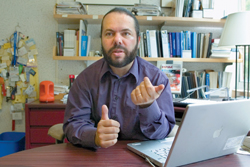
Globally, we see about $80 billion per year in weather-related economic losses, of which $20 billion are insured. This is like a “9/11” every year. Weather-related losses represent about 90 percent of all natural disaster losses, and the data I cited do not include an enormous amount of aggregate losses from small-scale or noncatastrophic events such as lightning, soil subsidence, and gradual sea-level rise.
Inflation-adjusted economic losses from catastrophic events rose eight-fold between the 1960s and 1990s, and insured losses by 17-fold. Losses are increasing about 10 times faster than insurance premiums. The insured share of total losses has increased dramatically in recent decades, and variability is increasing. Weather-related catastrophes have clearly visible adverse effects on insurance prices and availability. Of particular concern are the so-called “emerging markets” (developing countries and econo-mies in transition), which already have $375 billion per year in insurance premiums (about 12 percent of the global market at present, but rising), yet are significantly more vulnerable to climate change than are industrialized countries.
Increased exposures are heavily influenced by rising demographic and socioeconomic exposures. Yet, the rise in losses has outpaced population, economic growth, and in-surance penetration. The science of “attribution analysis” is still in pri-mitive stages, and thus we cannot yet quantify the relative roles of climate change and human activities.
VIEW: What is the significance of insurance companies identifying global warming as a problem?
MILLS: It’s significant in that it recognizes that the future may be different from the past, which is a departure from the way insurers understand many of the everyday risks they deal with. This is no small point, as insurers must anticipate and financially prepare for losses in advance of their occurrence. It also opens up the notion that insurers can play a role in the most profound type of risk management. They can actually stem rising losses by helping society address a root cause — in this case climate change.
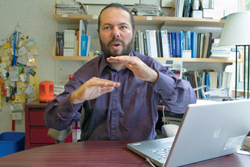
There are two major ways to approach risks: reactive and proactive. Insurers do both. Examples of the former include things like raising rates, withdrawing from certain exposures (like areas where hurricane risks are high, or from an entire category of loss such as household flood or certain crop risks), and shifting risks to governments as insurers of last resort.
But I don’t think being proactive is a radically new way for insurers to approach these kinds of problems. Insurers founded the original fire departments, building codes, and institutions like Underwriters Laboratories. The specter of climate change is still novel in terms of its scale, the long timeframe of the issue, and the truly global perspective required to address the root causes of these losses. It is no small challenge, and insurers and their regulators understandably have their hands full in dealing with many other issues.
So the good news is that insurers can use traditional tools to cope with these new risks. The challenge is that climate change presents an unprecedented set of risks and virtually all branches of the industry are vulnerable.
VIEW: How would you describe the insurance industry’s stance on the scientific evidence for global warming?
MILLS: As for any large industry, there’s no single answer. We still have a segment — much too large a segment — that hasn’t thought much about climate change at all. This group doesn’t yet have a strategy. Then there’s the group, including but not limited to insurers convened under a United Nations Environment Programme Initiative, who are tracking it very closely and are truly concerned. And, lastly, there is a small and shrinking group that disputes or feels unqualified to evaluate the scientific evidence. I would say that the middle group fully accepts the authoritative findings of the Intergovernmental Panel on Climate Change that human activity plays a central role in observed and anticipated climate changes, and the first group is inclined to accept it when it’s presented at a level they can understand and digest. Part of the challenge is bridging the scientific world and the financial world, which is what much of our research is about.
Of note, the insurance regulators, through the National Association of Insurance Commissioners, have taken very great interest in the climate change issue of late. I expect to see very constructive action from that quarter, in terms of fostering better modeling and data collection and assessment of potential financial impacts.
VIEW: How will climate change affect the average consumer trying to purchase homeowners or car insurance?
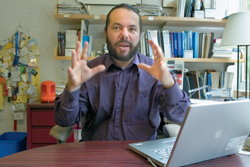
MILLS: As losses rise, so too will premiums. Similarly, deductibles can be increased or upper limits of coverage reduced. If done properly, this is appropriate. Like any industry, insurers need to cover their losses and generate a reasonable return for their shareholders. With the patterns of extreme weather events becoming more intense and more variable, the actuarial challenge will grow, and this will, in turn, put pressure on prices.
More importantly, however, is the question of whether certain hazards will become uninsurable, as has already happened, in part, with flood and crop risks related to weather. Questions along these lines are already being asked with regard to things like windstorm and wildfire.
We also need to keep in mind that this issue isn’t limited to property insurance. There is a very real link to insured business interruptions, highway accident rates, and various forms of liability insurance. Increased extreme weather events will also have impacts on health and life.
So the answer will reflect, in part, how the industry decides to respond. What I referred to earlier as reactive strategies will tend to result in the greatest burden for consumers, whereas proactive strategies will help reduce the long-term losses and maintain both the availability and affordability of insurance.
Scientists Reveal Why the Elderly Suffer More Bone Fractures
It’s no mystery that elderly people are more prone to bone fractures than younger people. What is a mystery is precisely why. Now, Berkeley Lab scientists have gained a better understanding of this problem using state-of-the-art imaging, testing techniques, and detailed mechanical analysis. They found that as people grow older, their bones lose their ability to resist the formation and growth of cracks that lead to breaks.
This insight into the mechanics of bone fractures could help scientists develop new ways to fight the effects of aging, injury and disease.

Robert Ritchie
“It is my hope that by understanding in detail the mechanisms by which healthy bone resists fracture, new therapeutic measures can be developed that will help preserve bone strength as people age,” says Robert Ritchie, a scientist with Berkeley Lab’s Materials Sciences Division (MSD) and chairman of UC Berkeley’s Department of Materials Science and Engineering.
People are more susceptible to bone fractures as they age, sometimes with dire consequences. Half the women and 25 percent of men over the age of 50 will have an age-related bone fracture sometime in their lives. Doctors have traditionally pinned this on the fact that bone mineral density decreases with age. But several recent studies have failed to find a direct link between changes in bone mineral density and risk of fracture, indicating that other factors may be involved. Perhaps changes in bone toughness — how well a bone’s structure resists fracture — is also a culprit. In other words, bone quality may play as much a role in fractures as bone quantity.
“Obviously it’s not good to lose bone mass, but we think that it’s only a part of the story. We need to really understand what happens to the structure of bone and how this affects its resistance to fracture,” says Ritchie.
To do this, Ritchie and fellow MSD scientists Joel Ager, postdoctoral fellows Ravi Nalla and Jamie Kruzic, and John Kinney of Lawrence Livermore National Laboratory turned to the same resources they’ve used to conduct pioneering research on advanced materials, composites and ceramics. These include mechanical testing techniques that examine how cracks behave in materials, and two Berkeley Lab user facilities that yield extremely high resolution images: the Advanced Light Source, where the nation’s premier source of synchrotron x-rays enables tomographic studies of materials, and the National Center for Electron Microscopy, where scientists conduct transmission electron microscopy characterizations of materials.
“We’ve been able to bring to bear Berkeley Lab’s absolutely state-of-the-art materials characterization techniques to help us better understand bone fracture,” says Ritchie.

The bones of young people are less susceptible to fractures than those of the elderly, a mystery scientists are trying to unravel.
The team used these tools to examine human cortical bone from cadavers that ranged in age from 34 to 99 years. Because bone is structurally unique at different scales, they examined the bone at the macroscale down to the nanoscale, where mineralized collagen fibers measure 50 to 70 nanometers in diameter (a nanometer is one billionth of a meter). They found that the resistance of bone to the initiation of cracks falls by 40 percent over the age range examined. Most strikingly, among the very elderly, cortical bone completely loses the ability to resist the growth of an existing crack.
The reason for this sharp drop-off in fracture resistance plays out on several size scales. Three-dimensional x-ray computed tomography images obtained at the Advanced Light Source and the Stanford Linear Accelerator Center reveal that the bones of younger people have large unbroken regions of bone between cracks. These unbroken “bridges,” which span tens of micrometers, act like steel rods in reinforced concrete (a micron is a millionth of a meter). In older people, however, the amount of these unbroken crack bridges is greatly reduced, meaning that it’s easier for one tiny crack to connect to another — the makings of a larger fracture.
“We see cracks opening up ahead of other cracks, and the regions in between act as bridges,” says Ritchie.
At the nanoscale, ultraviolet Raman spectroscopy studies reveal changes in the cross-linking underlying the collagen fibrils.
“With age, changes in the cross-linking of collagen fibrils stiffens the bone structure — much like fusing together a plate full of spaghetti,” says Ritchie. “This can make the bone more brittle.”
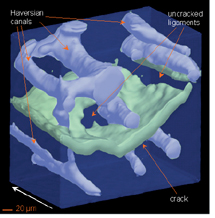
X-ray computed tomography of human bone performed at Berkeley Lab’s Advanced Light Source and the Stanford Linear Accelerator Center reveals nanoscale damage.
Although a hierarchy of structures at various size scales contributes to bone failure, Ritchie and his coworkers found that microcracks appear to initiate at the boundaries of osteons, which are concentric rings of collagen fibrils that surround blood vessels in bone. These osteons measure on the order of ten to several hundred microns across.
“This is the dominant dimension for fracture in bone and the scale of the microstructure that we think principally controls the fracture processes,” says Ritchie.
Ritchie believes this mechanistic understanding of bone failure could help inform the treatment of bone injuries and diseases such as osteoporosis. Currently, bone aging is treated in terms of a loss of bone quantity, but his team’s research reveals that other factors also play a role.
“Perhaps it’s time for new therapeutic treatments,” Ritchie says. “At one end there is a risk of fracture, and at the other end there is disease, aging and injury. We’re learning that structural changes link these two sides.”
This research is detailed in a number of recent publications, including the December 2004 issue of the journal Bone under the title “Effects of aging on the toughness of human cortical bone: Evaluation by R-curves.”
The Essence of Quintessence
What is the mysterious dark energy that’s causing the expansion of the universe to accelerate? Is it some form of Einstein’s famous cosmological constant, or is it an exotic repulsive force, dubbed “quintessence,” that could make up as much as three-quarters of the cosmos? A Berkeley Lab physicist believes there’s a way to find out.
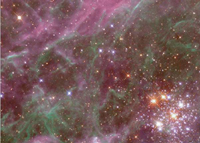
Quintessence is an exotic repulsive force that could make up as much as three-quarters of the cosmos and be responsible for the accelerated expansion of the universe.
In a paper published in Physical Review Letters (PRL), Eric Linder of the Physics Division and his collaborator, Robert Caldwell of Dartmouth College, show that physics models of dark energy can be separated into distinct scenarios which could be used to rule out Einstein’s cosmological constant and provide support for quintessence. What’s more, scientists should be able to determine which of these scenarios is correct, with the experiments being planned for the Joint Dark Energy Mission (JDEM) that has been proposed by NASA and the U.S. Department of Energy.
“Scientists have been arguing the question, how precisely do we need to measure dark energy in order to know what it is,” said Linder. “What we have done in our paper is suggest precision limits for the measurements. Fortunately, these limits should be within the range of the JDEM experiments.”
In their PRL paper, Linder and Caldwell describe two scenarios, “thawing” and “freezing,” which point towards distinctly different fates for our permanently expanding universe. Under the thawing scenario, the acceleration of the expansion will gradually decrease and eventually come to a stop. Expansion may continue more slowly or the universe may even recollapse. Under the freezing scenario, acceleration continues indefinitely.
Either of these two scenarios rule out Einstein’s cosmological constant. In their paper, Linder and Caldwell show for the first time how to cleanly separate Einstein’s idea from other possibilities. Under any scenario, however, dark energy is a force that must be reckoned with.
Said Linder, “Because dark energy makes up about 70 percent of the content of the universe, it dominates over the matter content. That means dark energy will govern expansion and, ultimately, determine the fate of the universe.”
Since the codiscovery of dark energy in 1998 by two groups — one of them the Supernova Cosmology Project headquartered at Berkeley Lab — cosmologists have been scrambling to explain its nature. One candidate is “quintessence,” named for the fifth element of the ancient Greeks, who believed it to be the force that held the moon and stars in place.
“Quintessence is a dynamic, time-evolving and spatially dependent form of energy with negative pressure sufficient to drive the accelerating expansion,” said Caldwell. “Whereas Einstein’s cosmological constant is a very specific form of energy — vacuum energy — quintessence encompasses a wide class of possibilities.”
The work by Linder and Caldwell has limited the possibilities for quintessence and provided firm targets for basic tests that would also confirm its candidacy as the source of dark energy. Such tests could be carried out aboard SNAP, the SuperNova/Acceleration Probe, one of the proposed vehicles for carrying out the JDEM mission.
Sharpening the Search for Dark Energy
SNAP Sponsors a Supernova Workshop
Almost eight years after its discovery, we know that dark energy accounts for more than two-thirds of the universe, but we don't know what it is. Strategies for choosing among different theories include tests of baryon oscillation and the weak lensing of galaxies.
"But Type Ia supernovae have the track record," says Alex Kim of Berkeley Lab's Physics Division. "They are how we discovered dark energy in the first place. They are how we have gotten the highest constraints on dark energy parameters. And they are empirically straightforward."
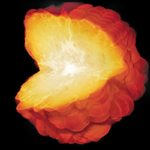
A model of a Type Ia supernova presented by Fritz Roepke of the Max Planck Institute for Astrophysics at the recent workshop sponsored by SNAP
The SuperNova/Acceleration Probe, or SNAP, with Saul Perlmutter as principal investigator and Michael Levi as co-PI, was designed to study dark energy from space by measuring the redshift and brightness of thousands of distant Type Ia supernovae. SNAP has grown to include more than a hundred scientists from a dozen institutions around the world; in 2003 SNAP inspired DOE and NASA to announce a Joint Dark Energy Mission (JDEM), which stimulated competing designs.
To address questions now being asked by JDEM's Science Definition Team and by NSF, NASA, and DOE's Dark Energy Task Force, the SNAP collaboration last week sponsored a workshop moderated by Kim and including both SNAP members and SNAP rivals — the world's leading Type Ia researchers.
For three days, the workshop attendees reported on ground-based searches for "nearby" supernovae, on searches for distant supernovae from the ground and from space, and on theoretical models of how these unique stars explode. They discussed innovative techniques for measuring and comparing Type Ia supernovae, including color magnitude diagrams and spectropolar-imetry.
The researchers tackled issues of calibration — how to compare observations made by different teams using different methods and different telescopes — and the sticky problem of sharing unpublished data. The aim is to nail down sources of variation in the limited population of known Type Ia supernovae.
"Until recently, Type Ia supernovae have been analyzed as a one-parameter family," Kim says. Although some Type Ia supernovae are intrinsically brighter than others, variations can be corrected simply by correlating brightness with the width of the light curve (the way an exploding star declines from its peak brightness). "What is a little worrisome is that there may be more than just that one parameter of variation."
Variations include differences in the width and velocity of key lines in Type Ia spectra; differences in light-curve shapes in different colors (the "second bump"); and degrees of polarization. Most basic, says Kim, "is the question of separating a supernova's intrinsic color from reddening by dust in the host galaxy or intervening space. Is color a second parameter?"
Kim says that "for cosmological purposes, some variations may be important, others may not matter. The bottom line is, we'd like to get the supernova community to say, 'These are the fundamental things we need to measure.'"
For a list of talks and workshop participants, see http://snap.lbl.gov/supernova_workshop/index.htm. More about the workshop and current research on Type Ia supernovae will appear in a forthcoming issue of the Lab's online magazine, Science@Berkeley Lab.
Solving the (Almost) Insoluble
Better Calculating Through Quantum Chemistry
A curious thing happened to chemistry in the early 20th century. Thousands of years of chemical trial and error were codified in a set of underlying physical laws, described by quantum mechanics and summed up in the Schrödinger equation.

An impressionistic view of why quantum computers are needed for exact solutions of the electronic structures of large molecules: as the information needed to describe each particle in the molecule increases, calculation time increases � exponentially in the case of classical computers (red), but more slowly in the case of quantum computers (orange).
Just one catch: exact solutions of the Schröedinger equation for any but the simplest chemical systems are, in the words of Paul Dirac, "much too complicated to be soluble." The time needed for computation increases exponentially with the size of the molecule; for any but the smallest molecules, exact solutions remain beyond the reach of the most powerful supercomputers.
Martin Head-Gordon of the Lab's Chemical Sciences Division is a professor of chemistry at UC Berkeley whose group has performed complex molecular calculations using clever approximations; but they also seek exact solutions the way Richard Feynman suggested a quarter-century ago, using quantum computers.
Recently the group announced they had simulated the process by which a quantum computer could calculate the ground-state energies of water (H2O) and lithium hydride (LiH) to high precision, the first calculations of this kind ever done for specific molecules.
"What we have done is demonstrate that quantum computing can deliver on the promise of giving highly accurate practical solutions to interesting chemical problems," says postdoctoral fellow Alán Aspuru-Guzik, who led the work.
The researchers developed a quantum-computational algorithm and ran it on a classical computer to demonstrate that a relatively small quantum computer — comprised of at most a few hundreds of quantum bits (qubits) — could calculate significant information about real molecular systems to high accuracy, surpassing the most powerful calculations possible with today's supercomputers.
Unlike classical computing, where each bit represents a 0 or a 1 but not both at once, a quantum bit superposes 0 and 1 and only resolves to a single value when measured. A classical computer operates serially, but a quantum computer's qubits interact to form very large computational spaces which, when measured, quickly deliver the solution to a complex problem.
No one has yet built a quantum computer that can compete with a classical computer. Hardware is part of the challenge, but so is devising practical algorithms that can run on quantum computers. Provided only a few qubits are involved, algorithms can be tested — if very slowly — on classical simulations of quantum computers.
Two factors were key to the Head-Gordon group's success. One was finding an efficient way to approximate an initial ground-state energy sufficiently close to the molecule's actual state. The researchers showed that with a method called "adiabatic state preparation," even a relatively crude initial estimate is practical.
Even more important was their adaptation of the "phase estimation algorithm." The original version of this quantum algorithm required a prohibitively large read-out register. By modifying it to perform recursively, approaching greater accuracy with each repeated calculation, they reduced the read-out register to a manageable number of qubits.
"Simulated quantum computation of molecular energies," by Alán Aspuru-Guzik, Anthony Dutoi, and Martin Head-Gordon, with Peter Love of D-Wave Systems, Inc., appeared in the September 9, 2005 edition of Science.
People, Awards and Honors
Outstanding Performance Honored

In recognition of their achievements �above and beyond regular job expectations,� 47 Lab employees were honored last month with Outstanding Performance Awards (OPAs). Most of them attended a reception hosted by Deputy Director Graham Fleming and Associate Lab Director David McGraw. Those attending are, left to right, John Taylor, Graham Fleming, Nigel Moriarty, Christine Trame, Athanasios Lykidis, Jeff Dickert, Tracy Bigelow, Jack Salazar, Olivia Wong, J. Alexander Liddle, Martin Jara, Dan Lunsford, Nancy Saxer, Natalia Ivanova, Alessandra Lanzara, Stephen Nobles, Edmund Christian Nelson, Jonah Weber, Michael Chin, Shuxia Zhou, Iain Anderson, Peter Denes, Alfred Early, David McGraw, Gregory Bell, Tim Williams, Kimberly Magbie, and Konstantinos Mavrommatis.
The full list of winners follows.
INDIVIDUAL OPA AWARDS: Gregory Bell, Tracy Bigelow, Wanyu Chan, Joseph Crippen, Mark Dedlow, Peter Denes, Alfred Early, Christina Galitsky, Alessandra Lanzara, J. Alexander Liddle, Meredith Montgomery, Edmund Christian Nelson, Stephen Nobles, Derek Radisky, Paul Ridgway, Robert Ritchie, Nancy Saxer, Penelope Siig, Joseph Wallig, Hongwei Wang, Tim Williams, Olivia Wong, Shuxia Zhou
The View Wins national communicators’ award
For the second year in a row, Berkeley Lab’s newspaper was a winner in the National Association of Government Communicators’ annual Blue Pencil competition. Berkeley Lab View was one of more than 600 entries received by NAGC this year. The View was recognized in the newspaper category.
Berkeley Lab View
Published twice a month by the Communications Department for the employees and retirees of Berkeley Lab.
Reid Edwards, Public Affairs Department head
Ron Kolb, Communications Department head
EDITOR
Monica Friedlander, 495-2248,
[email protected]
STAFF WRITERS
Dan Krotz, 486-4019
Paul Preuss, 486-6249
Lynn Yarris, 486-5375
CONTRIBUTING WRITERS
Jon Bashor, 486-5849
Allan Chen, 486-4210
David Gilbert, (925) 296-5643
Photography
Roy Kaltschmidt, 486-5731
Creative Services Office
FLEA MARKET
486-5771, [email protected]
Berkeley Lab
Communications Department
MS 65, One Cyclotron Road, Berkeley CA 94720
(510) 486-5771
Fax: (510) 486-6641
Berkeley Lab is managed by the University of California for the
U.S. Department of Energy.
Online Version
The full text and photographs of each edition of The View, as well as the Currents archive going back to 1994, are published online on the Berkeley Lab website under “Publications” in the A-Z Index. The site allows users to do searches of past articles.
Flea Market
- AUTOS & SUPPLIES
- ‘05 HONDA ACCORD DX, auto, ac, am/fm/CD, pwr win/locks, 5K mi, silver, good maint, $16,000/bo, 1 owner, Yamamichi, X5826, 206-1788
- ‘05 TOYOTA CAMRY LE, auto, 5K mi, gray ext & int, 26 MPG, $16,500, Dave, X4506, 710-7847
- ‘98 HONDA CIVIC EX, 4 dr, 5 sp, silver, exc cond, 105K mi, mostly freeway, $7,000, Nance, X7328, (707) 554-8204
- ‘91 MAZDA 323 hatchback, red, good cond, 118K mi, $1,200 firm, Steve, 530-5425
- ‘86 NISSAN MAXIMA GL, auto, ac, am/fm/cass, leather, moonrf, pwr, digital inst, light pewter, exc, orig owner, 155K mi, $1,900, (925) 935-6794
- HOUSING
- ALAMEDA, 2 bdrm/1 bth apt in Victorian bldg, hardwd flrs, built-in china cabinet, remod kitchen, on 3rd flr, laundry rm, no pets/smok, nr Park St/ Southshore/shopping/beaches, $1,350/ mo incl water, trash & recycling, street parking, avail now, Janice, 895-3584, [email protected]
- ALAMEDA, 1 bdrm/1 bth apt, high ceilings, updated kitchen, new carpets in Victorian bldg nr shopping ctr/beaches/trans, corner unit w/ lots of light, no pets/smok, $935/mo, Janice, 895-3584, [email protected]
- ALBANY, new custom-built & architect designed 2 bdrm/1 bth inlaw apt, priv ent, all-gas gourmet kitchen w/ stainless steel appliances, ultra quiet, Bosch dw, refrig, $1,550/mo + util & sec dep, pets neg, non-smok, JoAnne, 525-1963, [email protected]
- ALBANY, quiet sunny, furn/unfurn bdrm, nr rest/shopping/trans, parking space, easy access to UC and SF, share w/ student/prof’l, nr N Berkeley, $590, Matthias, 528-3377 until 11 pm
- BERKELEY, 1 bdrm avail in 2 bdrm/ 1 bth home, female room mate reg out of town, offstr parking, priv porch, laundry rm, satellite TV, nr Marina/trans/shopping/fwy, no smok/ pets, $600/mo + 1/2 util, 981-9918, [email protected]
- BERKELEY HILLS, Campus Dr top of La Loma, surrounded by trees, lge bthrm w/ tub, beamed ceiling, hrdwd flrs, storage space, highest speed DSL/ TV, cable at a shared cost, full kitchen w/ elec stove & dw, garden w/ fountain, street parking, no smok/pets, refs & credit check at appt will be appreciated, avail 8/25, Rozalina, 845-4624, [email protected]
- BERKELEY HILLS, 2 bdrm or lge 1 bdrm+office, furn, full bth w/ tub & shower, marble tile flr, kitchenette w/ refrig, dw, garbage disposal, microw & single burner cooktop, no stove, lge liv/din rm, w-w carpet, built-in bookcases, beamed ceilings, util incl gas, elec, water, garbage, free dig cable, sep ent, use of swim pool, nr pub trans/BART, $1,300, avail 10/1, 1st & last & sec dep of $1,000, incl non-refund cleaning fee of $300, Daniele, 559-7757, rmoorad@ earthlink.net
- KENSINGTON, furn rm avail for visiting staff, own 1/2 bath, kitchen & laundry, $550/mo, Ruth, 526-2007, 526-6730
- NORTH BERKELEY, furn rm w/ priv bth, sep ent, shared kitchen, common space, deck, single family home, resid area, nr UCB/LBNL/pub trans, no smok/pets, $500/mo, 528-9522
- PLEASANT HILL, spacious 3 bdrm/2 bth townhouse, 2-car garage, community pool/facil, short drive to shops/ BART, $1,600/mo, Derun, X5053, [email protected]
- PIEDMONT, sunny furn 2 bdrm/1 bth house w/ hills view, hardwd floors, big yard, laundry, garage, walk to Piedmont & Grand Ave, Piedmont schools, avail 1/06-7/06, $2,300/mo incl util, 2/mo, cleaning service, Laura, 655-4823, [email protected]
- HOUSING WANTED
- LONG TIME HOUSING needed in Berkeley for a postdoc, 2 bdrm, start end of August, [email protected]
- SABBATICAL VISITOR, Swiss, male, seeks furn accommodation, 10/1/05-2/28/06, [email protected] or Philip Haves, X6512, [email protected]
- MISC ITEMS FOR SALE
- AMPLIFIER/RECEIVER, Sony STR-DE925, 110W channel, Dolby Digital or DTS surround sound, 25+ optional preprogrammed sound fields cinema, concert hall, jazz club, rock club, $150, John, X6008, (925) 937-5231
- AQUARIUM, 50 gal acrylic, stand, canister filter, heater, $200/bo, Robert, X6002
- DOOR, antique interior w/ stained glass panels, $100, John, 849-1051
- DRYER, electric, 240 V heavy duty, white, ROPER brand, exc cond, $85, Damian, 638-1451
- MOTORCYCLE COVERS, 1 X/L, 1 med, never used, heavy weatherproof polyester, venting syst, reinforced brass grommets, shock cords w/ tiedown hooks, zippered storage bag, $45 each, X5783, 919-9550 cell
- PRINTER, Mac Stylewriter II inkjet, barely used, black ink cartridge, pwr cord & cable, exc cond, works w/ Macs w/ parallel port, no USB, $25, Melissa, 665-5572 msg
- REFRIGERATOR, 21.6 cu ft side by side, good cond, almond, $300, Maureen, X4595, (925) 372-6707
- SF OPERA TICKETS, Italian Girl in Algiers, Sat 9/24, 8 pm, 2nd row balc, pair, $124/pr, Paul, X5508, 526-3519
- SKIS (2), FISHING ROD, skis: Head Sport, 5737, 180 cm, radius 5.0; Blizzard 190 cm (made in Austria), no bindngs, bo; fishing rod: Fenwick Woodstream, quality, bo, 601-5757 eve/msg
- WASHER, Maytag, dependable care heavy duty, 2 speed super capacity, white, model LAT4914AAE; Maytag elec dryer, white, model DE309, works great, $150/bo, Laura, (650)796-0938, (650)728-3878
- WINDSURFER, fair cond, some parts missing, you pick up in San Francisco, Nat, X5308